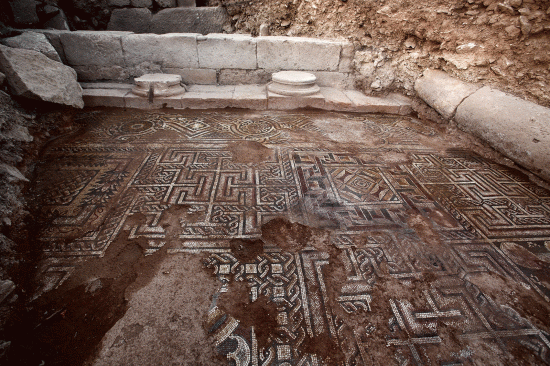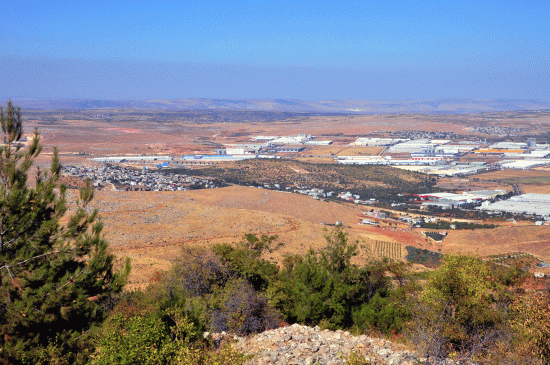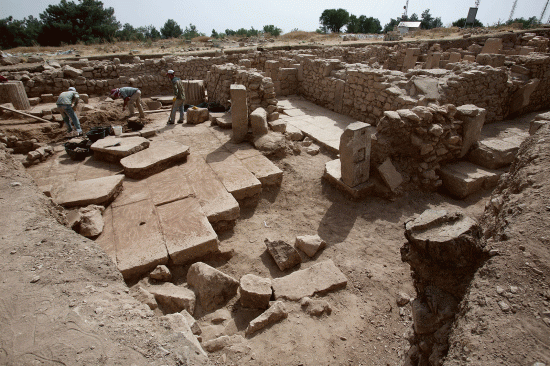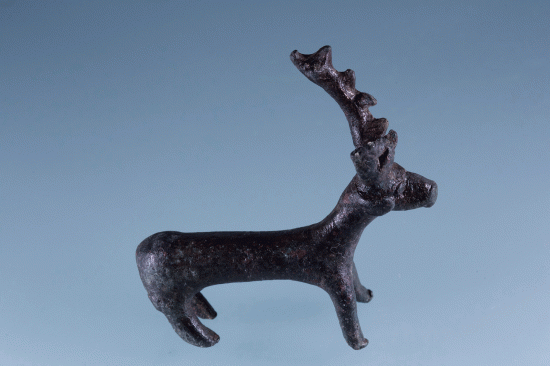WWU Münster
Source - http://www.uni-muenster.de/Religion-und-Politik/en/aktuelles/2015/nov/PM_Ausgrabungen_Roemisches_Syrien.html
 Part of the excavated mosaic floor of a late antique building - Foto: Peter Jülich
Part of the excavated mosaic floor of a late antique building - Foto: Peter Jülich
Münster classical scholars discovered invaluable ancient Syrian mosaics and buildings and are excavating one of the few sites that are currently accessible for studies on ancient Roman Syria despite the tense political situation in the Middle East. “The ancient city of Doliche, which was part of the province of Syria in Roman times, lies at the fringes of the Turkish metropolis of Gaziantep today”, explains Prof. Dr. Engelbert Winter from University of Münster’s Cluster of Excellence “Religion and Politics”. “The city is one of the few places where Syrian urban culture from the Hellenistic-Roman era can currently still be studied.” Urban centres of this kind have thus far barely been explored. Famous sites in today’s Syria that would qualify for such research, such as Apamea or Cyrrhus, have either been destroyed or are inaccessible because of the war.
Prof. Winter spoke towards the end of the first excavation season of the new excavation project on urban development in ancient Syria, which the German Research Foundation (Deutsche Forschungsgemeinschaft, DFG) is funding with a total of 600,000 euros starting this year. At the same time, the researchers are continuing their excavations in the sanctuary of Iuppiter Dolichenus, in which the Cluster of Excellence is involved.
 View from Dülük Baba Tepesi of the urban area of Doliche, situated on the mound at the centre of the picture - Foto: Forschungsstelle Asia Minor"
View from Dülük Baba Tepesi of the urban area of Doliche, situated on the mound at the centre of the picture - Foto: Forschungsstelle Asia Minor"
“The situation today at the site of Apamea, one of the most important ancient cities of Syria, is particularly bad”, according to Prof. Winter. “Illicit excavations, clearly visible in satellite imagery, have destroyed the entire urban area. It remains doubtful if research there will ever be possible again. The excavations in Cyrrhus, which had recently been resumed, also had to be stopped due to the current situation.” On the other hand, the ancient city of Antioch on the Orontes, formerly the capital of the Roman province of Syria and today the Turkish metropolis of Antakya, is largely inaccessible as a result of modern construction. “For the time being, therefore, our excavations in the city of Doliche, which is situated on Turkish territory and which can, in addition, well developed through extensive preliminary work and accessible to archaeological research, can provide new information about the urban culture in the ancient Northern Syrian midland”, says excavation director Prof. Winter of the University of Münster’s Asia Minor Research Centre.
Outstanding mosaic with delicate pattern
“The most outstanding discovery of our excavations is a high-quality mosaic floor in a splendid complex of buildings with a court enclosed by columns that originally covered more than 100 square metres”, explains archaeologist Dr. Michael Blömer. “Because of its size and the strict, well-composed sequence of delicate geometric patterns, the mosaic is one of the most beautiful examples of late antique mosaic art in the region.” Even if the building’s function is as yet unclear, it has to be a wealthy urban villa. “These first findings already reveal the potential that the site has for further research into the environment of the urban elites and for questions as to the luxurious furnishing in urban area.”
 View of the newly excavated parts of the abbey of St. Solomon at Dülük Baba Tepesi - Foto: Peter Jülich
View of the newly excavated parts of the abbey of St. Solomon at Dülük Baba Tepesi - Foto: Peter Jülich
The team of researchers is also excavating simple houses, alleys and water pipelines, which promise to give major insights into the everyday life of the people and the city’s organisation, according to Dr. Blömer. In 2016, the excavations are planned to be extended to the public areas of the ancient city. New information as to key questions can be expected from the project: “By means of different methods, we hope to obtain a reliable picture of a Northern Syrian city from the Hellenistic era to the age of the crusaders as well as a clearer picture of the material everyday culture and of local identities in this region, the research of which is still in its early stages as regards ancient Syria.”
Excavations at a near-by overhanging rock shelter revealed a significantly older epoch: it housed a Palaeolithic settlement site dating back to 600,000 to 300,000 BC. “People settled here because there was flint from which tools were crafted”, according to Prof. Winter. “Some of our new finds can already be dated back to around 300,000 BC. Therefore, we plan to expand research on this site, which is central to the early history of humankind, into an individual project.”
Bronze figurine of a stag
 Bronze figurine of a stag from the early 1st millennium BC - Foto: Peter Jülich
Bronze figurine of a stag from the early 1st millennium BC - Foto: Peter Jülich
Simultaneously with the restart of the DFG funded excavation in the urban area of Doliche, a second group continued with the excavations on the neighbouring mount, Dülük Baba Tepesi, in the sanctuary of Iuppiter Dolichenus, one of the most important gods of the Roman Iron Age. Excavations there have been going on for 15 years. In addition to well-preserved sections of the wall enclosing the Roman sanctuary, further parts of a Christian abbey, founded on the mountaintop after the end of the heathen cult, were excavated. Researchers have been able to retrieve many valuable finds in recent years, showing that the site had already been used as a sanctuary in the 9th and 8th centuries BC, thus making it much older than initially assumed. This was confirmed this year by the find of a high-quality bronze figurine of a stag which also dates back to the early 1st millennium BC.
The project B2-20 at the Cluster of Excellence, “Media representation and religious ‘market’: Syrian cults in the Western Imperium Romanum” is closely linked to the excavation project. The focus is on local cults developing into state religions. (vvm)